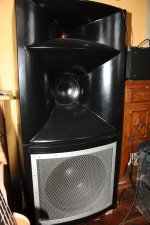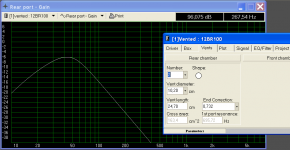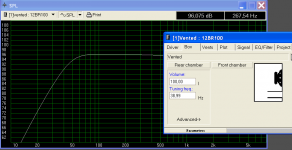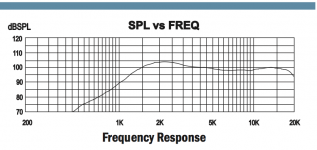and how/where will you suggest to crossover bass to mid ?
Read it in topic 35
http://www.diyaudio.com/forums/multi-way/230094-design-horn-high-sensitivity-speakers-4.html#post3373203
The mid is 300Wand 600 peak no problemo to filter it first order 100 or 200Hz . That is why I would choose 200Hz fist order to meet sensitivity of the front horn.
Last edited:
100hz ?
not confident the RCF mid driver will do that
200hz ?
might be too high, and a problem at the other end
and 200hz might still be at the limit of the mid's 1mm Xmax
but mounted in a fronthorn it might be a different matter
I really think this might be a real good speaker, and a clever design
but it will take a lot more time and many practical tests to make it work
not confident the RCF mid driver will do that
200hz ?
might be too high, and a problem at the other end
and 200hz might still be at the limit of the mid's 1mm Xmax
but mounted in a fronthorn it might be a different matter
I really think this might be a real good speaker, and a clever design
but it will take a lot more time and many practical tests to make it work
Shure you can filter it 100Hz a loudspeaker works also under its resonance frequency. It is only about the right impedance for the amplifier to keep it 8ohm.100hz ?
not confident the RCF mid driver will do that
200hz ?
might be too high, and a problem at the other end
and 200hz might still be at the limit of the mid's 1mm Xmax
but mounted in a fronthorn it might be a different matter
I really think this might be a real good speaker, and a clever design
but it will take a lot more time and many practical tests to make it work
There are closed sub designs who only work under the resonance frequency. When you make notes like that better think about it.
The X-max of the 10MR is 1,4mm. this is with first order at 200Hz 111dB output the 10MR will reach x-max at 150Hz. Then it works still linear.
Even rcf advises it from 150Hz up I think you see problems that doesn't exist in this design. Also the tight suspension of the mid will protect the driver.
It is a 10 inch mid Charly will use a 5W amplifier but even 100w will be no problem with this 10inch mid. I would even use the 10MR without filter without problems I am sure. Fliter is only needed to get the right impedance for the amplifier.
Last edited:
according spec sheet the RCF mid rolls off from 500hz, without the horn
and seems to be usual behaviour for these kinds of special PA mids
not 100% sure, but RCF normal way to list Xmax could be PP specs, which means the 1.4mm Xmax would be like +/-0.7mm
and seems to be usual behaviour for these kinds of special PA mids
not 100% sure, but RCF normal way to list Xmax could be PP specs, which means the 1.4mm Xmax would be like +/-0.7mm
That is not a problem as you look to the raising output of the hornsub that i correct with the 1 order filter at 100hz to gather it will become a flat response.according spec sheet the RCF mid rolls off from 500hz, without the horn
and seems to be usual behaviour for these kinds of special PA mids
Then the horn will filter the frequencies above 400hz it self.
Still above 200hz it will not reach a extrusion of 0,7mm even with high power because it is 10 inch.not 100% sure, but RCF normal way to list Xmax could be PP specs, which means the 1.4mm Xmax would be like +/-0.7mm
This discussion is a non issue in this hifi application
Last edited:
to reduce cost alternative 100dB 10" mid driver. Still the flatness of the RCF10MR and closed back is easy to work with.
eminence
Speaker Detail | Eminence Speaker
BC
B&C SPEAKERS
18sound
10NMB420 - High Output MB Neodymium Driver
beyma
http://profesional.beyma.com/pdf/10MI100E.pdf
rcf
http://www.usspeaker.com/rcf%20-%20L10L750yk-1.htm
rcf 10MR $300
http://www.usspeaker.com/rcf%20-%20mr10n301-1.htm
eminence
Speaker Detail | Eminence Speaker
BC
B&C SPEAKERS
18sound
10NMB420 - High Output MB Neodymium Driver
beyma
http://profesional.beyma.com/pdf/10MI100E.pdf
rcf
http://www.usspeaker.com/rcf%20-%20L10L750yk-1.htm
rcf 10MR $300
http://www.usspeaker.com/rcf%20-%20mr10n301-1.htm
Last edited:
A few simple recommendations
1) Do NOT try to use the Mid horn at too low frequencies. Doing so is a sure recipe for trouble (i.e. distortion, "horn honk", ...). As a rule of thumb, keep the Woofer-Mid crossover frequency (Fx) > 2 * Fc (twice the horn cutoff).
2) Do NOT try to use first order (6 dB/oct) crossovers. They just don't work with horns (their unfiltered lower roll-off at Fc is already at least 2nd order); they also let through way too much high-frequency energy (above Fx) coming from the woofer.
3) Do NOT be scared by the "choppy" response (comb filtering due to interference) throughout the Mid-Tweeter crossover region: it just isn't audible. Human hearing isn't sensitive to phase anomalies at the typical Mid-Tweeter crossover frequencies (> 6kHz). On the other hand, a good Tweeter invariably sounds better than a Compression driver in the top octave (> 10kHz)
Marco
1) Do NOT try to use the Mid horn at too low frequencies. Doing so is a sure recipe for trouble (i.e. distortion, "horn honk", ...). As a rule of thumb, keep the Woofer-Mid crossover frequency (Fx) > 2 * Fc (twice the horn cutoff).
2) Do NOT try to use first order (6 dB/oct) crossovers. They just don't work with horns (their unfiltered lower roll-off at Fc is already at least 2nd order); they also let through way too much high-frequency energy (above Fx) coming from the woofer.
3) Do NOT be scared by the "choppy" response (comb filtering due to interference) throughout the Mid-Tweeter crossover region: it just isn't audible. Human hearing isn't sensitive to phase anomalies at the typical Mid-Tweeter crossover frequencies (> 6kHz). On the other hand, a good Tweeter invariably sounds better than a Compression driver in the top octave (> 10kHz)
Marco
Here isn't horn on the mid driver Marco.
A colleague of my made a note about steep filters they create distortion deu the steep cut off and have therefor a own sound. This shout be compensated by the crossed other driver I think when it works well.
This is also the reason for horn honk sound imo the step cutoff that is what you hear.
So go for first order to prevent honkynes. Or be sure of a perfect fit of the two drivers for steep filtering.
A colleague of my made a note about steep filters they create distortion deu the steep cut off and have therefor a own sound. This shout be compensated by the crossed other driver I think when it works well.
This is also the reason for horn honk sound imo the step cutoff that is what you hear.
So go for first order to prevent honkynes. Or be sure of a perfect fit of the two drivers for steep filtering.
Last edited:
Hi guys,
Me again 🙂
I have no doubts of your expertise, and that mid range woofer could be a good approach,
It s appearance was due to my concerns about highs dispersion.
I am envisioning a horn speaker,just because in my experience with the Everest 55000, they are great. Also the Avant garde mids and highs are wonderful, but I didn't liked bass on those, also very weird but in my experience with avant garde, they don't Rock.
So I guess this comes from a dream of having good horn speakers. Because of that, I wouldn't like to have. 10inch driver. Probably great design and sounding but it deviates from my dream of having horns.
So I would be willing to sacrifice that highs directivity, or adding another super tweeter or small waveguide later.
I have heard Lecleach have better sounding for small rooms then iwata?
Another question is, why adding a 10inch woofer don't introduces combing filtering, but a 2405 does ?
Even time alignment of the acoustical centers won't fix this?
Have a great day mates!
Charly
Me again 🙂
I have no doubts of your expertise, and that mid range woofer could be a good approach,
It s appearance was due to my concerns about highs dispersion.
I am envisioning a horn speaker,just because in my experience with the Everest 55000, they are great. Also the Avant garde mids and highs are wonderful, but I didn't liked bass on those, also very weird but in my experience with avant garde, they don't Rock.
So I guess this comes from a dream of having good horn speakers. Because of that, I wouldn't like to have. 10inch driver. Probably great design and sounding but it deviates from my dream of having horns.
So I would be willing to sacrifice that highs directivity, or adding another super tweeter or small waveguide later.
I have heard Lecleach have better sounding for small rooms then iwata?
Another question is, why adding a 10inch woofer don't introduces combing filtering, but a 2405 does ?
Even time alignment of the acoustical centers won't fix this?
Have a great day mates!
Charly
Hi guys,
Another question is, why adding a 10inch woofer don't introduces combing filtering, but a 2405 does ?
Even time alignment of the acoustical centers won't fix this?
Charly
When you place the drivers with a center to center spacing within wavelength then wave fronts will mix resonable good. When you have a horn with a diameter of 50cm. center spacing can not be smaller then 25cm.
a wave length of 25cm = 344/0,25= then a super tweeter shout be crossed 1370Hz or lower to get CTC right.
In the 3 way design the 10inch diameter 23,5cm center spacing=21,75cm
The wave guide 14,7cm center spacing is 7,35cm
CTC=21,75+7,35=29,1 344/0,291=1198Hz
That is why I advise second order 1kHz when you use DE250 on the seos 10 you even can do 900Hz second order nice wave front with less interference distorsion.
Your idea is about owning a horn. A horn is a devise that directs the sound wave in one direction thats why its out put is very high.
When you use a wave guide you also direct the wave in one direction only with very short flair. This prevents horn coloration known as homs.
So with the wave guide you get constant directivity and high SPL as a horn. So you get only the goodies of a horn not the bad things and they are small that is good for time alignment with the mid.
It is more modern to use a wave guide when you take all positive and negative points in considering.
A super tweeter crossed at lets say 5khz has a wave length of 6,9cm, so that would mean you have to CTC with in 6,9 cm.
This wont work so you get combing may causing what you like peaks on you high frequent causing a false detail effect.
As far I know the everest and avangarde are not horn low but basreflex bas types.Hi guys,
I am envisioning a horn speaker,just because in my experience with the Everest 55000, they are great. Also the Avant garde mids and highs are wonderful, but I didn't liked bass on those, also very weird but in my experience with avant garde, they don't Rock.
Charly
My exspirence with box design is the level of low to the spl level of midhigh makes a speaker sound warm or clean/thin with to much highlevel.
That is a point to test when designing the filter to make the spl levels fit to each other till you hear what you like.
When you make bas with a peak between 50 an 100 Hz you get a kick bas effect.
Like this Magico Q5 a peak at +8dB 55Hz.
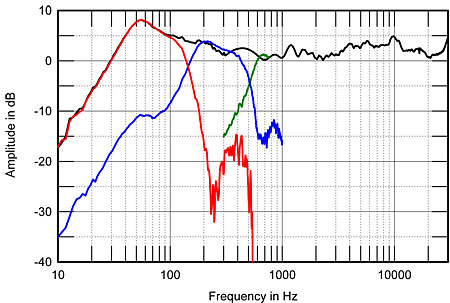
Last edited:
I built this for my bass
I have no idea what the heck Im doing, but I think it at least looks ok
and since its only for bass guitar, it probably already too good for that
whatever, just an experiment I wanted to try
but maybe imagine the mid horn could be a big tweeter horn instead 😉
I have no idea what the heck Im doing, but I think it at least looks ok
and since its only for bass guitar, it probably already too good for that
whatever, just an experiment I wanted to try
but maybe imagine the mid horn could be a big tweeter horn instead 😉
Attachments
You like compact monitors tinitus😀for my bass
don't know if its good, I just wanted to try it
There's always this, for inspiration : DIY Paper Horn - The Paper Horn by Inlow SoundNo replies?
Maybe my question was not specific enough?
Ok, what if I create a system? Maybe you can tell if it s going to work or make suggestions for change and Improvement?
Ok, here I go:
1. Super tweeter: JBL 2405
2. Mid: bms 4591
3. Bass: Eminence, omega pro 18 (only because already available) in some kind of enclosure.
I imagine having first order crossover points around 400hz and 6khz.
I would like to haveat least 100db
I would like to go down at least to 40hz
Is obvious to me the 97db woofer is an issue! May be go active for the bass?
Is the 2405 and iwata 4591 plus bin bass a good starting point?
I have heard 1 inch CDs are preferable.
Also wondering if a better woofer, like a new pro JBL could improve things.
Help for this enthusiastic ignorant is very needed.
Thanks.
There's always this, for inspiration...
yep, a paper mache' horn is a really cool idea
It s appearance was due to my concerns about highs dispersion.
I am envisioning a horn speaker,just because in my experience with the Everest 55000, they are great.
Another question is, why adding a 10inch woofer don't introduces combing filtering, but a 2405 does ?
Charly
To make a everest copy.
You can look on ebay or so for a 2" JBL 2380A biradial horn.
http://www.fullcompass.com/common/files/7942-2380a.pdf
An externally hosted image should be here but it was not working when we last tested it.
A altenative for a jbl 2405 slotted tweeter.
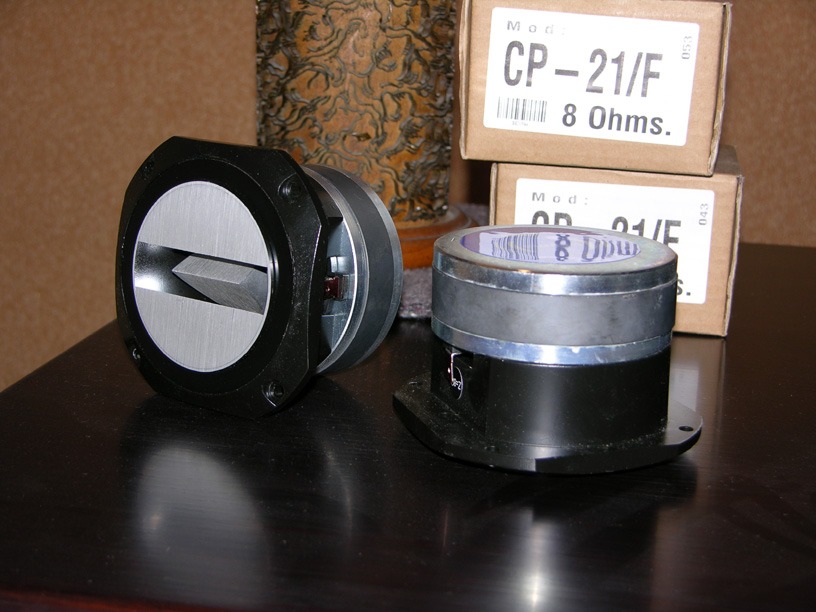
http://profesional.beyma.com/ingles/pdf/CP21F.pdf
http://www.bcspeakers.com/CPD/product_pdf.php?id=0000000037
Or this horn tweeter.
http://profesional.beyma.com/ingles/pdf/CP25.pdf
nice studio woofer to make jbl everest 55000dd double woofer look.
http://profesional.beyma.com/pdf/12B100-RE.pdf
Beyma Speakers - Beyma 12B100R speaker - Beyma 12B100R 300 watt 12" woofer for all hi-fi and studio monitor bass speakers. Beyma 12B100R and other Beyma 12" speakers here.

simulation of two drivers in one box.
Attachments
Last edited:
Small rectangular horn tweeter P-audio.
http://www.paudiothailand.com/pdf/products/PHT-409.pdf
http://www.paudiothailand.com/pdf/products/PHT-409.pdf
An externally hosted image should be here but it was not working when we last tested it.
Attachments
Many thanks.
What to you think if we work arround this topology, but now make it more DIY.
If I build an Everest Clone, it will look very Pro, and kind of cheap.
But I think we could work on the concept and design something arround this?
("We" sounds like a lot of people 🙂 )
For instance:
1) Those Beyma woofers look very cool, and look like quality output, and better midrange because of reduced size. Probably I will be wrong, but those 96db per single driver would end up in arround 100db with two drivers per enclosure? Is this an advantage compared to use a single 15 inch driver? I guess this will give cleaner midrange for using with a horn for the highs? Just wondering it wont reach 40hz.
2) The 2380A could be replaced by a hand made Iwata horn? I could work the wood, and it would be a nice touch. Another option would be a tullip lecleac'h from Autotech, if this sounds better. I've heard people saying Round horns sound better in home rooms.
3) I could get a pair of vintage JBL 2405 for arround 300USD. I am going to Canada in the start of march and a friend could grab them for me from the states since we are meeting at winnipeg.
I have seen this like a reference, but it doesn't have to look the same, just reference of what look cool to me:
Reference: http://www.avsforum.com/avs-vb/attachment.php?attachmentid=204682&stc=1&d=1299638506
I think this guy make a good design (in terms of aestetics). Also like the modular concept, since you can update your system without loosing all your work.
Please forgive me if I say any heresy, I am just too noob 😉
Best!
What to you think if we work arround this topology, but now make it more DIY.
If I build an Everest Clone, it will look very Pro, and kind of cheap.
But I think we could work on the concept and design something arround this?
("We" sounds like a lot of people 🙂 )
For instance:
1) Those Beyma woofers look very cool, and look like quality output, and better midrange because of reduced size. Probably I will be wrong, but those 96db per single driver would end up in arround 100db with two drivers per enclosure? Is this an advantage compared to use a single 15 inch driver? I guess this will give cleaner midrange for using with a horn for the highs? Just wondering it wont reach 40hz.
2) The 2380A could be replaced by a hand made Iwata horn? I could work the wood, and it would be a nice touch. Another option would be a tullip lecleac'h from Autotech, if this sounds better. I've heard people saying Round horns sound better in home rooms.
3) I could get a pair of vintage JBL 2405 for arround 300USD. I am going to Canada in the start of march and a friend could grab them for me from the states since we are meeting at winnipeg.
I have seen this like a reference, but it doesn't have to look the same, just reference of what look cool to me:
An externally hosted image should be here but it was not working when we last tested it.
An externally hosted image should be here but it was not working when we last tested it.
Reference: http://www.avsforum.com/avs-vb/attachment.php?attachmentid=204682&stc=1&d=1299638506
I think this guy make a good design (in terms of aestetics). Also like the modular concept, since you can update your system without loosing all your work.
Please forgive me if I say any heresy, I am just too noob 😉
Best!
Last edited:
You probably will only make a Everest look loudspeaker, not a clone or copy. The best that I can think of is already shown in topic 35.
I do not have any special feelings for JBL stuff. If you like jbl buy a secondhand 4343 for example and make it like new again. Then you own a real JBL not any poor copy.
Loudspeaker building is not about buying good horns and drivers, that is only a small part of making a good speaker.
All the aspects as constant directivity, impulse behavior, phase and impedance control, ctc spacing and know the behavior to sound of different wires and capacitors.
That is what makes the good sounding speaker. Not in the first place a expensive driver.
You have a picture in your head what you like your speaker to look and how to sound. I do not think this will work through a topic like this.
I do not have any special feelings for JBL stuff. If you like jbl buy a secondhand 4343 for example and make it like new again. Then you own a real JBL not any poor copy.
Loudspeaker building is not about buying good horns and drivers, that is only a small part of making a good speaker.
All the aspects as constant directivity, impulse behavior, phase and impedance control, ctc spacing and know the behavior to sound of different wires and capacitors.
That is what makes the good sounding speaker. Not in the first place a expensive driver.
You have a picture in your head what you like your speaker to look and how to sound. I do not think this will work through a topic like this.
Last edited:
- Status
- Not open for further replies.
- Home
- Loudspeakers
- Multi-Way
- Design: Horn High Sensitivity Speakers
